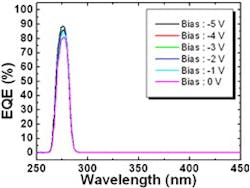Solar-blind UV photodetector has record-high external quantum efficiency of 89%
| An aluminum gallium arsenide based detector grown on sapphire substrate shows an unbiased peak external quantum efficiency (EQE) of 80%, increasing to 89% under a 5 V reverse bias. (Image: Northwestern University) |
Evanston, IL--Manijeh Razeghi and her group at Northwestern University’s McCormick School of Engineering and Applied Science have developed the world’s highest quantum-efficiency ultraviolet (UV) photodetector, potentially useful for detection of missiles and chemical and biological threats.1
An aluminum gallium arsenide (AlxGa1-xN)-based detector array was grown on a sapphire substrate; the device design was optimized through experiment, varying the design and amount of doping and testing various devices against each other. The peak response wavelength of the optimized device, which has an area of 729 μm2, is 275 nm.
When unbiased, the detector shows an external quantum efficiency (EQE) and responsivity of about 80% and 176 mA/W, respectively; when subjected to a reverse bias of 5 V, the EQE rises to 89%. The researchers say that, minus reflection losses, this translates to a 98% internal quantum efficiency.
The development of UV photodetectors has been driven by applications in the defense, commercial, and scientific arenas. Until recently, photomultiplier tubes (PMTs) or silicon photodetectors with UV bandpass filters were the only viable options for imaging in this important spectral range. Thanks to technological and scientific advances in the III-Nitride material system, high aluminum composition AlxGa1-xN-based semiconductor structures have become a promising alternative.
Spotting missile plumes
“Heat sources such as flames, jet engines, or missile plumes emit light throughout the UV portion of the spectrum corresponding to their blackbody temperature,” says Razeghi, director of Northwestern’s Center for Quantum Devices. “These man-made UV sources can easily be detected at wavelengths less than 290 nm due to the nonexistence of a terrestrial background signature. The military, in particular, is interested in developing ground- and air-based solar-blind sensors to detect the UV signature of an active missile plume and provide early warning and potentially allow for missile tracking and ultimately interception.” The military could also use UV detectors and sources to detect biological threats.
The visible-rejection ratio of the new Northwestern-developed detector is more than six orders of magnitude, ensuring that virtually all non-UV light is rejected in measurements.
The group will now work to create a UV focal-plane array with high uniformity and an operability of higher than 95%. The research is supported by the US Navy.
REFERENCE:
1. E. Cicek et al., Applied Physics Letters 103, 191108 (2013); http://dx.doi.org/10.1063/1.4829065
